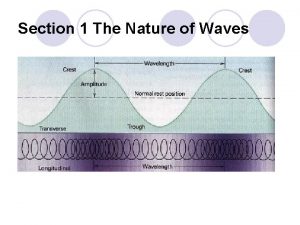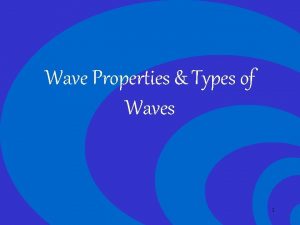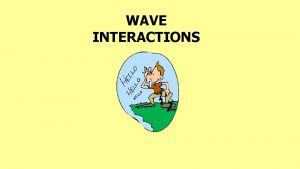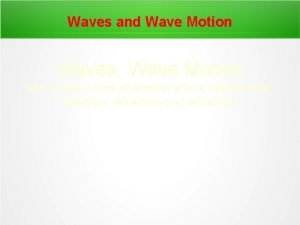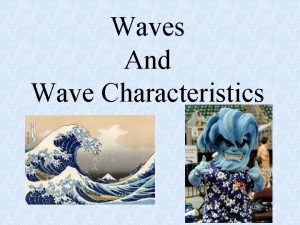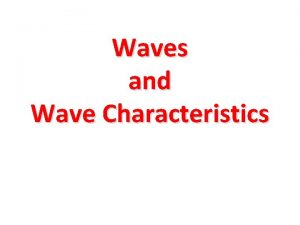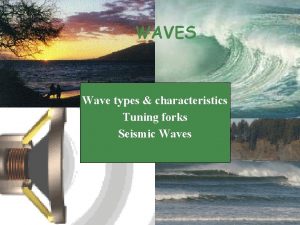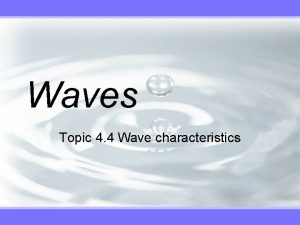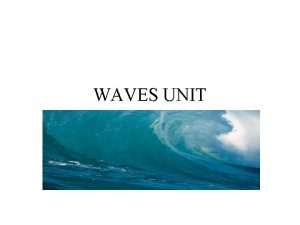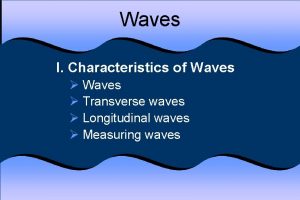WAVE UNIT SECTION 2 NOTES Characteristics of Waves






















- Slides: 22

WAVE UNIT: SECTION 2 NOTES Characteristics of Waves

Transverse Waves: An ideal transverse wave has the shape of a sine curve and looks like an “S” lying on its side. The simplest transverse waves have similar shapes no matter how big they are or what medium they travel through.

Parts of Transverse Waves Crests: highest points of a transverse wave Troughs: lowest points on a transverse wave Amplitude: greatest distance that particles in a medium move from their normal position Distance from the rest position to a crest or to a trough. Wavelength: distance from one crest to the next or from one trough to the next. Basically, it is the distance between any 2 successive identical parts of a wave.

Diagram of Transverse Waves crest trough

Parts of Longitudinal Waves The particles move back & forth (parallel) instead of up & down (perpendicular) Compressions: crowded areas in a longitudinal wave Rarefactions: stretched out areas in a longitudinal wave Wavelength: distance between 2 compressions or between 2 rarefactions

Diagram of a longitudinal wave:

Wavelength In equations, wavelength is represented by the Greek letter lambda, λ Because wavelength is a distance measurement, it is expressed in the SI unit meters.

Amplitude and Wavelength: Energy The larger the amplitude of a wave, the more energy it carries. Example: Waves of destructive earthquakes have greater amplitudes, and therefore more energy, than minor earthquakes. The shorter the wavelength of a wave, the more energy it carries.

Period Period: the time it takes one full wavelength of a wave to pass a certain point. In equations, the period is represented by the symbol T. Because period is a time measurement, it is expressed in the SI unit seconds (s).

Frequency Frequency: the number of wavelengths that pass a point in a given time interval The symbol for frequency is f. SI Unit: Hertz (Hz) Named after Heinrich Hertz, the scientist who demonstrated existence of electromagnetic waves in 1888. Hertz units measure the number of vibrations per second. We can hear sounds in the range from 20 Hz to 20, 000 Hz.

Frequency-Period Equation:

Wave Speed

Wave Speed Example The average wavelength in a series of ocean waves is 15. 0 m. A wave crest arrives at the shore on average every 10. 0 s, so the frequency is 0. 100 Hz. What is the average speed of the waves? v=f x λ v= 0. 100 Hz x 15. 0 m v= 1. 50 m/s

Wave Speed and Medium Speed of a wave depends on the medium: Sound travels through air at 340 m/s (about 770 miles per hour) Since sound travels fast in air, you don’t notice a time delay in most situations. Sound travels three to four times faster in water than in air. If you swim with your head underwater, you can hear certain sounds very clearly. Dolphins use sound waves to communicate with one another over long distances underwater.

Wave Speed and Medium Sound waves travel even faster in solids than in air or water. Sound waves have speeds 15 to 20 times as fast in rock or metal as in air. Although the speed of a wave depends on the medium, the speed in a given medium is constant; it does not depend on the frequency of the wave. No matter how fast you create waves on a rope, they still travel at the same speed; it just increases the frequency and decreases the wavelength.

Wave Speed and Phases of Matter Wave speed in gases: a molecule must pass through a lot of empty space before it bumps into another molecule; therefore, waves don’t travel as fast in gases as they do in liquids and solids Wave speed in liquids: particles are closer together & free to slide past one another & waves move faster Wave speed in solids: particles are packed very tight together, so vibrations occur very rapidly, so waves travel very fast

Speed of Light Speed of light in empty space: 3. 0 x 108 m/s (671, 000 mi/h) (186, 000 mi/s) The speed of light is a constant that is represented by the lowercase letter “c”. Light travels slower when it has to pass through a medium like air or water.

The Doppler Effect Have you ever been to a racetrack and noticed how the sound differs as the cars pass around the track? The motion between the source of waves and the observer creates a change in observed frequency. In the case of sound waves, motion creates a change in pitch.

The Doppler Effect The pitch, how high or low a sound is, is determined by the frequency of the waves. A high-pitched sound is caused by sound waves of a higher frequency.

The Doppler Effect A. ) When an object is not moving, the frequency of the waves is the same at all locations. B. ) When an object is moving, the sound waves are closer in front and farther behind. The person in front hears a higherpitched sound.

The Doppler Effect So, the Doppler Effect is: an observed change in the frequency of a wave when the source or observer is moving.

The Doppler Effect
 Differences between mechanical and electromagnetic waves
Differences between mechanical and electromagnetic waves Sound waves are longitudinal waves true or false
Sound waves are longitudinal waves true or false Energy that travels through
Energy that travels through Similarities of mechanical and electromagnetic waves
Similarities of mechanical and electromagnetic waves The wave chapter 13
The wave chapter 13 Sound is a longitudinal wave
Sound is a longitudinal wave Carbon dioxide temperature
Carbon dioxide temperature Difference between matter waves and electromagnetic waves
Difference between matter waves and electromagnetic waves Electromagnetic waves vs mechanical waves
Electromagnetic waves vs mechanical waves Similarities of mechanical and electromagnetic waves
Similarities of mechanical and electromagnetic waves Surface waves and body waves
Surface waves and body waves Seismic waves are mechanical waves
Seismic waves are mechanical waves Compare and contrast p waves and s waves using venn diagram
Compare and contrast p waves and s waves using venn diagram What do all waves transmit
What do all waves transmit What are constructive waves
What are constructive waves Ability of two or more waves to combine and form a new wave
Ability of two or more waves to combine and form a new wave Waves pdf
Waves pdf Difference between full wave and half wave rectifier
Difference between full wave and half wave rectifier Example of longitudinal wave
Example of longitudinal wave Half wave rectifier meaning
Half wave rectifier meaning Center tapped full wave rectifier vs bridge rectifier
Center tapped full wave rectifier vs bridge rectifier Determining the arrival times between p-wave and s-wave
Determining the arrival times between p-wave and s-wave Rectified sine wave fourier series
Rectified sine wave fourier series















